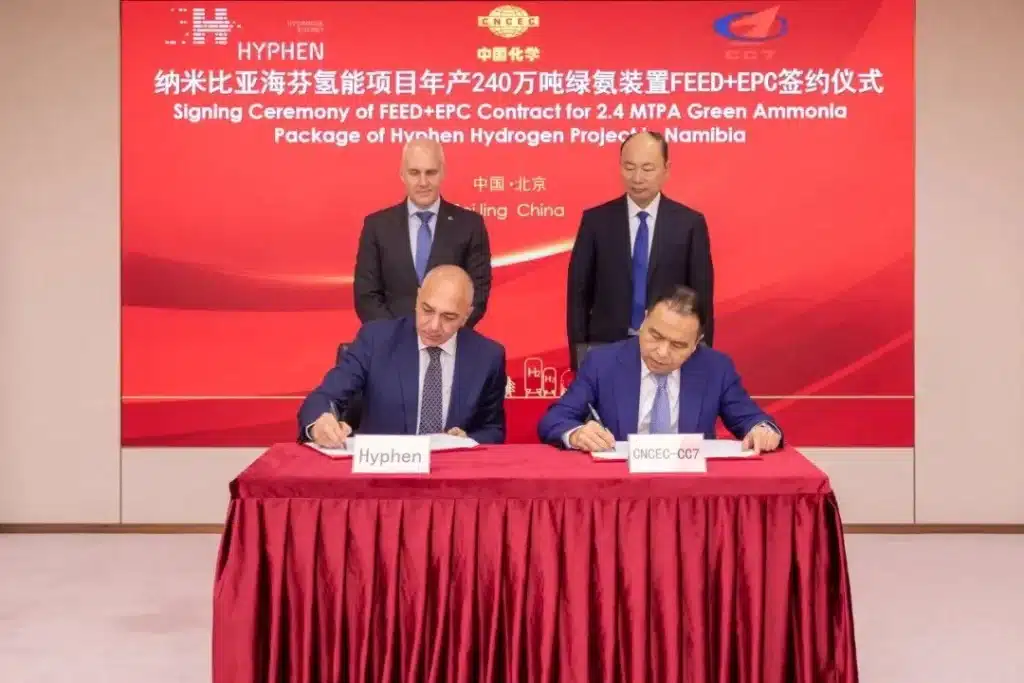China produces 42 million metric tons of contained nitrogen annually, representing approximately 30% of global ammonia production, yet the award of Front-End Engineering Design and EPC contracts to China Chemical Engineering Seven (CC7) for Namibia’s 2.4 million tonne green ammonia facility signals a strategic shift toward renewable production technologies. The $10 billion Hyphen project, roughly equivalent to Namibia’s entire GDP, will utilize 3GW of renewable capacity to produce what developers claim will be the world’s largest green ammonia facility, though the economic fundamentals underlying this ambitious scale remain largely untested.
The scale of the proposed facility dwarfs existing green ammonia projects globally, raising questions about demand absorption and technological execution risks. While offtake agreements are reportedly in place for half the projected 2 million tonnes of ammonia for European export, the remaining capacity requires market development that may not materialize at projected timelines or pricing assumptions.
Engineering Execution and Technical Complexity
CC7’s selection reflects Chinese engineering capabilities in large-scale chemical processing facilities, yet green ammonia production at this magnitude remains technologically unproven. The company’s conventional ammonia experience provides relevant foundations, but renewable energy integration, hydrogen production scaling, and ammonia synthesis coordination present complex operational challenges that prototype projects have not fully resolved.
The 3GW renewable energy requirement represents substantial infrastructure development across wind and solar technologies in Namibia’s desert regions. Grid stability, energy storage, and production scheduling complexities increase exponentially with scale, creating technical risks that engineering contractors typically address through proven designs rather than innovative approaches required for green hydrogen integration.
Namibian green hydrogen production costs are estimated at $2 per kilogram, though these projections depend on capacity utilization rates, renewable energy reliability, and equipment performance that large-scale deployment may not achieve. Cost competitiveness requires sustained operational efficiency across integrated systems where individual component failures can impact entire production chains.
Market Dynamics and Demand Validation
Global ammonia production exceeds 180 million tonnes annually, primarily serving fertilizer markets with established pricing mechanisms and distribution networks. Green ammonia targets different applications, including shipping fuel, power generation, and industrial processes, where market development remains nascent and pricing acceptance uncertain.
European import demand drives project rationale, yet energy security considerations and domestic production incentives may reduce long-term import requirements. Saudi Arabia’s $8.4 billion green ammonia project and similar Middle Eastern developments create supply competition that could pressure pricing assumptions underlying Namibian project economics.
The project’s phased approach begins with 300,000 tonnes annual production before scaling to full capacity, providing market validation opportunities before complete capital commitment. However, phased development increases unit costs and extends payback periods that may challenge project financing structures.
Economic Impact and Development Implications
The claimed contribution of more than 80% to Namibia’s GDP represents unprecedented economic transformation for a single industrial project. This projection appears to conflate project investment value with ongoing economic contribution, as operational facilities typically generate revenues substantially below initial capital expenditure on an annual basis.
Employment projections of 15,000 construction jobs and 3,000 permanent positions provide significant workforce development for Namibia’s 2.6 million population. However, these positions require technical skills that domestic labor markets may not supply, potentially necessitating international workforce arrangements that reduce local economic benefits.
Infrastructure development, including ports, power transmission, and transportation network,s requires substantial additional investment beyond the $10 billion project cost. These supporting investments may require government financing or multilateral development funding that extends total project costs and implementation timelines.
Financial Structure and Risk Assessment
The project’s joint venture structure between Germany’s Enertrag and UK-based Nicholas Holdings, with 24% Namibian government participation, creates complex governance arrangements for a project exceeding the host country’s economic scale. Risk allocation among partners becomes critical when project revenues determine national economic performance.
The $10 billion investment approximately equals Namibia’s GDP, creating concentration risks that could destabilize the national economy if project performance falls short of projections. Currency exposure, commodity price volatility, and operational challenges typical of first-of-kind projects become magnified when economic impacts reach this scale.
Financing arrangements for projects of this magnitude typically require multilateral development banks, export credit agencies, and commercial lending consortiums with extensive due diligence requirements. Project approval processes may extend implementation timelines and increase financing costs that affect overall project viability.
Geopolitical Considerations and Technology Transfer
Chinese engineering leadership in Africa’s largest renewable energy project reflects broader Belt and Road Initiative dynamics where infrastructure development serves multiple strategic objectives. Technology transfer arrangements between CC7 and local partners may influence long-term operational capabilities and economic benefits.
European offtake agreements create supply chain relationships that may face geopolitical pressures if international relationships deteriorate. Energy security considerations could influence contract terms, pricing mechanisms, and long-term demand reliability that project economics require.
The partnership between Chinese engineering capabilities and European-led development creates precedent for renewable energy industrialization in developing countries. Success or failure will influence similar project development across Africa and other regions where renewable resources exceed domestic demand.
Implementation Timeline and Market Development
Commercial operation timelines remain undefined despite contract awards, reflecting the complexity of coordinating renewable energy development, hydrogen production facilities, and ammonia synthesis at unprecedented scale. Similar projects typically require 5-7 years from engineering completion to full operation, extending market exposure periods for all participants.
Market development for green ammonia requires parallel progress in shipping infrastructure, handling facilities, and end-user applications that remain early-stage across global markets. Project success depends on coordinated development across multiple sectors and jurisdictions that individual projects cannot control.
The Namibian project’s outcome will significantly influence global green ammonia market development by demonstrating technical feasibility, economic viability, and operational performance at a commercial scale. These results will determine whether similar projects proceed or whether the industry pursues smaller, more manageable development approaches.





